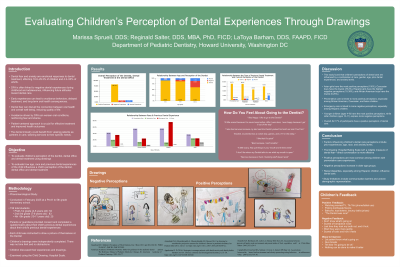Patient Management
78 - Evaluating Children’s Perception of Dental Experiences Through Drawings


Marissa Spruell, DDS
Resident
Howard University, Washington, D.C.
Howard University College of Dentistry
Washington, District of Columbia, United States- RS
Reginald Salter, DDS, MBA, PhD, FICD
Assistant Professor Comprehensive Dentistry and Director Admissions, Student Activities & Programs
Howard University
Washington, District of Columbia, United States - LB
Latoya Barham, DDS, FAAPD, FICD
Associate Professor, Chair and Residency Director
Howard University
Washington, District of Columbia, United States
Presenting Author(s)
Research Mentor(s)
Program Director(s)
Purpose: The aim of this 3-month phenomenological study is to evaluate children’s perception of the dentist, dental office, and dental treatment using drawings, as well as its association with age, race, and previous dental experiences
Method: Children between the ages of 5 and 11 were recruited for the study. Participants classified under the SCHN category were excluded. Each child was invited to create a freehand drawing of themselves visiting the dentist and receiving treatment. These drawings were then evaluated using the Child Drawing: Hospital (CD:H) Scale for Pediatric Dentistry to assess levels of dental anxiety. Following the drawing activity, children were encouraged to explain their artwork and share general thoughts about their dental experiences.
Results: This study explored associations between race, gender, age, dental experiences, and children's perceptions of dental care. Asian girls reported the highest positive perception of the dentist (100%), while Caucasian boys had the lowest (78.27%). Hispanic girls showed the highest negative perception (15.38%), whereas African American boys had the lowest (6.25%). Overall, 82.17% of participants expressed a positive perception of the dentist, 7.64% negative, and 8.92% neutral. Age influenced perception, with 4–6-year-olds showing the highest positive perception (89.90%) and 10–11-year-olds the highest negative perception (28.00%). While the CD:H scale suggested most children had low anxiety, verbal feedback often indicated otherwise. Preventative care was most common among African American (55.56%), Caucasian (43.03%), and Asian (37.50%) children, while 76.00% of Hispanic children had only received emergency care. Restorative treatment was the least common across all groups. Notably, children who had only received preventative care reported the highest positive perceptions, while those with emergency-only care reported the lowest. These findings suggest that demographic and experiential factors significantly shape pediatric dental perceptions.
Conclusion: This study concludes that the Children's Drawing: Hospital Rating Scale is not an effective tool for assessing dental fear and anxiety, as it often fails to reflect children's true feelings—direct communication proves to be more reliable. The type of previous dental experience significantly shapes a child's perception of the dentist, with negative experiences leading to less favorable views. Additionally, children's perceptions tend to become more negative with age, and Hispanic children demonstrated the highest percentage of negative perceptions overall. Study limitations included communication challenges and uneven participant group sizes, which may have influenced the findings.
Identify Supporting Agency and Grant Number: N/A

.jpg)